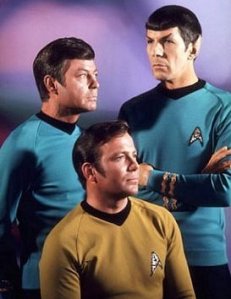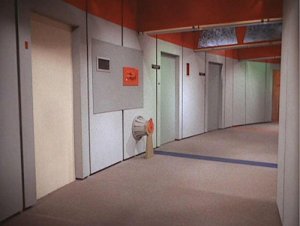Wednesday, February 13th, 2008
•
Horrorthon Posts

In the ‘Sixties, television production companies had a much simpler and more primitive relationship with the networks and their viewers than they do today. Remember that there was no “fourth network” like FOX, no cable TV at all, and no “first-run syndication” networks. There were no VCRs, either (let alone seasonal DVD boxed sets). Every single television viewer was using “rabbit ear” antennae to pick up broadcasts (and struggling to adjust the “vertical hold” and clear out the static by turning knobs and bending their antennae all over the place). It goes without saying that there was no internet; no downloadable episodes; no fan sites; no viral marketing; nothing except you, your TV, and maybe a big rooftop antenna if you were lucky. (Early Trek fans actually traded cassette tapes of the episodes’ soundtracks…by mail.)
So, with the exception of soap operas, nobody was really trying to get a continuous story going. The networks tended to make up their own minds about what order to broadcast shows in, and viewers who missed individual episodes had absolutely no way to make up for it and see what they missed or even find out what happened on the show except to wait for reruns or hope that some newspaper or magazine would print a summary. (No primetime hourlong drama really used the “soap opera” continuous story technique until Dallas and Hill Sreet Blues.)
The effect of this on Star Trek was twofold: first, they weren’t thinking in terms of big, sequential story events, except in the vaguest sense. There was no “Series Premiere,” no “Season Finales,” no “cliffhangers” (except for a single two-part episode) and no “previously on Star Trek.” The Trek fictional universe is rigidly planned and consistent; the order of events is just a little vague. (And forget about the “stardates:” they’re deliberately scrambled, and remain that way until The Next Generation.) When the show was cancelled halfway through its third season, no attempt was made to “wrap up the story” in a J. J. Abrams sense; the whole thing just…stops…with no closure at all. Of course, certain chronological developments are established: Ensign Pavel Chekov (Walter Koenig) joins the Enterprise crew in the second season, and Yeoman Janice Rand (Grace Lee Whitney) leaves because of “personal reasons” (DRUGS), and the characters occasionally refer to events from previous episodes.
But the whole thing is very piecemeal, and the episodes weren’t even broadcast in the order that they were filmed. For example, once NBC had greenlighted the show, Roddenberry decided to begin series production with a script called “The Corbomite Maneuver” (since it was a simple, shipboard story that would let the cast and crew get into the groove of the show), and to carefully write the script so as to introduce certain elements explicitly. NBC ignored all that and broadcast “The Man Trap” first, which is a perfectly fine “action-adventure” story but not the greatest episode all around (and it got some bad reviews).
Which brings me to my point: Paramount Home Video, in their infinite wisdom, decided to release the Star Trek DVD sets based on the show’s broadcast order rather than the production order. It doesn’t make that much difference, since, as I’ve explained, the shows were designed to be viewable in any order as was the custom of the day. (I sound like Abe Simpson.) But Star Trek purists like myself prefer to watch the shows in production order, for all kinds of reasons. (I’m such a pathetic Trekkie that I’m even aware of when they made certain changes to the sets.) Paramount’s arbitrary, bone-headed decision to arrange the DVDs the way they did is the kind of thing that makes me ridiculously, murderously angry; the fact that “it doesn’t matter” and “it’s so trivial” just makes me angrier about it, if you can dig it. If I actually owned the commercial DVD sets I would be cursing Paramount Home Video every time I played the discs. (I have similar murderous feelings about the people who are making the “remastered” Trek episodes, since they’re getting so many things right and spending so much money, and it will never happen again, and it’s a wonderful, unprecedented development except for the fact that they’ve completely, irrevocably, hopelessly fucked it up.) Anyway, here’s a Wikipedia list that gets the episodes into the proper order.
Now I’m going to “go get a life, for crying out loud” as Mr. Shatner has famously suggested.
Tuesday, February 12th, 2008
•
Horrorthon Posts


Saturday, February 9th, 2008
•
Horrorthon Posts

Thanks to jpx and JSP I had the opportunity to select and critique my ten favorite original Star Trek episodes (posted here on Horrorthon). It was a surprisingly rewarding endeavor, since it forced me to document a few decades’ worth of Trek thinking. While working on something else the last couple of days (involving a lot of coding) I decided to take my own advice and watch my ten faves, in the same broadcast-order I listed them.
All I can say is, JSP, you’re in for quite an experience. (I’m actually envious; I would love to see TOS for the first time as an adult.) Coming back to this stuff, I’m consistently amazed at just how good it all is. Every one of these episodes has quite literally given me chills as I watched. (Right now, I’m three-quarters of the way through The City on the Edge of Forever, in which the contrasting portions written by Harlan Ellison and by Gene Roddenberry have an almost Lennon/McCartney counterpoise going on.) I think if one were to go back in time and tell the cast and crew of the show that they were launching a franchise that would lead to eleven feature films and five more television series and a permanent place in the world’s popular culture, they would be stunned and baffled. I mean, these guys were eating lunch every day in the Paramount/Desilu cafeteria next to the cast of Bonanza; not exactly an environment for forging an immortal mythos on a Homeric scale. (The James Bond franchise is slightly older, with twice as many movies, but the pieces don’t all fit together the same way and the whole thing is much less substantive.)
Original Trek is obviously great television (although its cinematic limitations are beginning to date badly; see my original remarks) and, as I’ve tried to suggest, great drama, but the show’s achievements as science fiction are particularly remarkable. Watching today, in the iPhone/Obama era, I’m consistently struck by the deep intelligence underlying the show’s concepts of future technology and society. Star Trek‘s understanding and presentation of computers and communication systems are astonishingly accurate and predictive, as is the multi-racial casting and the gender balance represented by Roddenberry’s utopian starship crew. Remember that the Enterprise’s voice-activated “library computer” was created by writers using manual typewriters who had probably never seen a real computer in their lives; similarly, the show’s “communicators” (which are almost exactly like cell phones except that you hold them in front of your face instead of next to your ear; that’s the only detail they got wrong) were invented in a time that pre-dated even personal paging devices by a decade, when a portable phone involved a heavy backpack and was only available to soldiers in combat. As David Gerrold (author of the beloved second season episode “The Trouble With Tribbles”) wrote in 1973,
Star Trek is the visualization of such a basic concept that it is a whole genre of science fiction: the spaceship exploring new worlds. While Gene Roddenberry did not create the original concept, he fleshed it out so completely that all future motion picture or television attempts to explore this area will be forced to solve many of their problems the same way that Star Trek did. Just as it is impossible to write a science fiction story about robots without being aware of Isaac Asimov’s massive body of work in the area, it will be impossible to do stories of interstellar explorers without recognition of the ground covered by Star Trek.
The idea of creating a full-fledged fictional universe spanning across multiple stories is older than written language, of course, but the scheme of using episodic television to do it was absolutely brand new, completely invented here. George Lucas instigated what may be regarded as a “counter-reformation” ten years later, throwing away the Trek earnestness and progressive values in exchange for a return to 1930s serial adventures; the subsequent sci-fi-movie frenzy was so overwhelming that it actually changed Trek, and all eleven movies and all the spinoff shows must be considered in light of the Lucas/Spielberg revolution. But the original show, captured in digital amber on DVD, is a one-of-a-kind achievement. As depression-era visionary Edith Keeler puts it (in The City on the Edge of Forever), “I don’t pretend to tell you how to find happiness and love when every day is a struggle to survive, but I do insist that you do survive, because the days and the years ahead are worth living for.” (No wonder Kirk fell for her.) Nobody had walked on the moon when Roddenberry sat down at his typewriter and started dreaming. Ten years later, Star Trek was long gone, seemingly never to return, but the first NASA space shuttle orbiter was named “Enterprise” in tribute to his dream.



